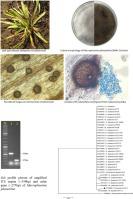Journal of Applied Research on Medicinal and Aromatic Plants ( IF 3.9 ) Pub Date : 2020-11-23 , DOI: 10.1016/j.jarmap.2020.100288 Ram Prasnna Meena , Vasudha A. Kadam

|
Safed musli, Chlorophytum borivilianum Santapau & R.R. Fern. is an important medicinal plant due to aphrodisiac and immuno-modulatory properties. Leaf blight disease showing characteristic symptom of necrosis spots on tips and outer margin of leaves, which gradually progressed and cover large portion of leaf lamina. Severe infection causes premature drying of leaves, which give blighted appearance as observed on safed musli growing field of ICAR-Directorate of Medicinal and Aromatic Plants Research, Anand, Gujarat (India). Associated putative fungus was isolated from single microsclerotia and characterized through cultural, morphological and microscopic studies. The association of putative fungus confirmed by pathogenicity test on potted safed musli plants. Mycelium of the causative organism showed dark olive black colonies that ultimately turns black and were found embedded with abundant of microsclerotia. Morphologically microsclerotia were black, smooth, round to oblong, 49.88 - 99.74 ± 5.62 μm in diameter. Pycnidia were exclusively observed on the infected leaves of C. borivilianum, were dark to greyish, globose, membranous and 83.62- 123.88 ± 3.77 μm in diameter. Conidia were single celled, hyaline, aseptate, obovoid and measuring 13.83 - 17.28 ± 0.37 μm × 5.39 - 7.28 ± 0.28 μm. By comparing with available relevant literature, the fungus was tentative identified as Macrophomina phaseolina. The identity of associated pathogen was further confirmed by molecular sequencing of internal transcribed spacer (ITS) of rDNA region and actin gene. In vitro efficacy test showed that among the tested fungicides, metalaxyl 4.0% + mancozeb 64% causes highest mycelial growth inhibition (90.00%) at both, 0.1 and 0.2% concentration and of Pseudomonas fluorescence (PF7) showed 51.72% mycelial growth inhibition.
中文翻译:

表征了与叶枯萎病相关的巨噬性菜豆(Phophophomina phaseolina)与叶枯萎病Santapau&RR Fern。及其杀真菌剂的敏感性
Safed musli,吊兰Santapau和RR Fern。由于壮阳药和免疫调节特性,它是重要的药用植物。叶枯病表现为叶片的尖端和外缘有坏死斑的特征性症状,并逐渐发展并覆盖大部分叶片。严重的感染会导致叶片过早干燥,这在印度古吉拉特邦阿南德的药用和芳香植物研究的ICAR主任安全的musli生长田中观察到,出现枯萎的外观。从单个的菌核中分离出相关的推定真菌,并通过文化,形态学和显微镜研究对其进行表征。通过对盆栽安全的musli植物进行的致病性测试证实了推定真菌的关联。致病菌的菌丝体显示出深橄榄色的黑色菌落,这些菌落最终变成黑色,并被发现内含大量的菌核。形态上的微菌核是黑色的,光滑的,圆形到长方形的,直径为49.88-99.74±5.62μm。仅在被感染的叶子上观察到了钩虫病。C. borivilianum,暗至灰色,球形,膜状,直径83.62- 123.88±3.77μm。分生孢子为单细胞,透明质酸,腹水形,卵圆形且大小为13.83-17.28±0.37μm×5.39-7.28±0.28μm。通过与现有相关文献进行比较,该真菌被初步鉴定为菜豆虫。通过对rDNA区域和肌动蛋白基因的内部转录间隔区(ITS)进行分子测序,进一步证实了相关病原体的身份。体外功效测试表明,在所测试的杀菌剂中,浓度为0.1和0.2%的甲霜灵4.0%+麦考布64%引起最高的菌丝体生长抑制(90.00%),假单胞菌荧光(PF7)表现出51.72%的菌丝体生长抑制。



























 京公网安备 11010802027423号
京公网安备 11010802027423号